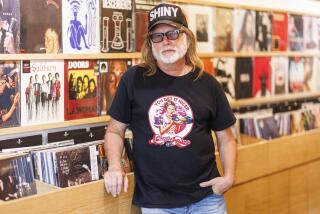Great Read: As vinyl returns, they’ve got it covered
Thousands of old-style cardboard sleeves for Jack White’s album “Lazaretto” sit in tightly packed checkerboard rows at Stoughton Printing plant in the City of Industry, 12.3-inch squares waiting to be stuffed with 12-inch circles.
Jack Stoughton Jr., son of the company’s founder, takes one from the newly printed stack and admires the work. White’s blue suit pops off the print as he sits amid a flock of angel statuettes. The inside of the jacket is black — one more flourish to separate it from the others in the increasingly competitive vinyl business.
Nearby, a heavy Heidelberg press pushes Stereolab jackets across a conveyor belt: a reorder of the British band’s 1993 drone-rock gem, “Transient Random-Noise Bursts With Announcements,” with its close-up image of a turntable tone arm gliding across an album.
In the vinyl comeback of the last decade, people like to credit the so-called warmth of LPs. But don’t overlook the artfully crafted jacket. After all, if a label expects fans to spend money on music that’s available for free online (and pay a premium over a download or CD), the object had better be desirable.
And Stoughton makes them desirable.
“It’s like when you get into an Audi or a BMW. You shut the door and it has that sound,” says Patrick McCarthy, project manager for Light in the Attic Records, a reissue label that uses Stoughton for most of its packages. “It’s this almost imperceptible quality, but you know it when you have it in your hands.”
Founded nearly 50 years ago, the unassuming company has ridden a roller-coaster ride from ubiquity to near-death and back, enduring the 45 rpm single, 33 1/3 rpm album, eight-track, cassette, compact disc, laser disc, MP3 and streaming eras — an arc that captures the history of the music business itself.
Jack Jr. recalled the company’s early years, after a young Jack Stoughton left a solid job at Bert-Co Press, at the time the music industry’s biggest L.A. printer, in the budding Los Angeles vinyl world of the early 1960s.
“Dad’s motto was, ‘Large enough to serve you, small enough to know you.’”
::
Each day thousands of jackets are crafted with Stoughton’s heavy machinery and its employees’ deft hands, a rainbow run of colors and titles rolling along presses and glue machines.
You might find employees hand-sticking printed slicks of the War on Drugs’ new “Lost in the Dream” onto high-grade cardboard gatefold sleeves, referred to in industry parlance as “old style tip-on jackets” for the way they’re constructed. Or working with Fullerton indie punk label Burger Records on the design for a cardboard cassette box. Or brainstorming an ultra-secret project involving a high-profile rapper.
With five weeks’ worth of a queue behind it, the company is running night shifts all year long for the first time in ages and expanding its printing capacity — all for a product declared dead in the early 1990s.
Need a glossy tip-on like jazz label Impulse! used to do in the 1960s a la John Coltrane’s “Ascension”? Want something with leatherette finish like Crosby, Stills, Nash & Young’s “Deja Vu”? Stoughton’s got it. The dull, uncoated texture of the Grateful Dead’s “Workingman’s Dead”? No problem; Stoughton has worked with the Dead for years. Elvis Presley’s mega-selling catalog, including the multi-platinum “Aloha From Hawaii Via Satellite,” bought the company a new building.
“Theirs look like the way it’s supposed to be,” says Ben Blackwell, who oversees vinyl production for White’s Third Man Records imprint. “When you look at an old Beatles record, before people were able to print direct to board, this is how they did it. They printed a slick, it had to be cut, and it had to be glued on and folded.” At Stoughton, the final two steps are done by hand.
Jack Jr., who runs the company with his younger brother Clay and a host of descendants and longtime employees, credits the labels that Stoughton works with for a renaissance in LP art.
“They’re stretching the limits of what we do, and they’re making us look at it again fresh,” he says. “Specialty papers, specialty inks, special matches, coatings, finishes, embossing, UV — you name it, they’re doing it, and they’re not afraid of it. They want to put out the best record they can put out. Not just from the sound, but the package is part of the artistry of the whole thing.”
::
At the company’s headquarters, a two-story entryway features a wall of fame: Nirvana’s debut, “Bleach,” hangs alongside Rod Stewart’s “Every Picture Tells a Story.” Frames hold Metallica’s “Ride the Lightning,” Joanna Newsom’s “Ys,” Cuban all-star band Buena Vista Social Club’s debut, Father John Misty’s “Fear Fun.”
A virtual history of art of the album era, shelves contain samples, negatives, color separations and more. The more you dig, the more there is to discover, especially upstairs in the building dubbed “the house that Elvis built,” where thousands of game-board sized cardboard envelopes hold old color negatives and reference art.
Though not many remain from the company’s early years, when it was born near Vermont Avenue and Santa Monica Boulevard, the sheer volume of commissions represented is overwhelming.
“That market was growing like crazy,” Jack Jr., the third of Jack Sr.’s four children, says of those years. Soon companies Ode, A&M and Elektra commissioned Stoughton to print the circular LP labels stamped into the middle of albums. Through work with Capitol, Stoughton pressed the iconic Apple label for the Beatles — two sides of a halved Granny Smith.
The company committed to the jacket business when it landed RCA, producing titles for budget country and big band labels including Pickwick, as well as “a whole bunch of Elvis stuff.” Just as today, the slicks were mounted to cardboard. Eventually Stoughton grew to making the whole product: their “old-style tip-on” jackets.
All would have been fine were it not for technology.
“One day CDs were born, and that industry in Southern California collapsed almost overnight,” Jack Jr. says.
The music business virtually cut out jacket printers when introducing the (hideous) plastic CD jewel case. Luckily, around that time the laser disc was born.
The video format was nearly the same size as a 12-inch record, and Stoughton soon controlled that market, doing “every movie you could think of, just about,” says 26-year Stoughton vet Rob Maushund, including the “Star Wars” jackets, the lauded Criterion Collection series and Woody Allen’s “Manhattan.”
In the fall of 1999, Jack Jr. says, one of its clients surpassed production of 1 million discs per month. Two months later, that same company announced it was ceasing production, conceding the market to the nascent DVD format.
Recalls Jack Jr.: “We were like, ‘Really?’”
::
The resident music obsessive, Maushund cuts a unique figure as he sits in his office near Stoughton’s wall of fame. An old-school skater with a foot-long gray beard and a punk history dating to the early ‘80s, he’s worked on thousands of jackets, box sets and deluxe packages over the years. The best of it is showcased in a wall of record shelves in his office. It’s a covetous collection until you realize few have the actual records in them.
Like many at the company, Maushund has had a front row seat to the format’s shifting fortunes as laser discs vanished and music fans were forgoing the object altogether.
Maushund, who works closely with labels to realize their grandest ideas, says that unlike the popular narrative, the company is proof that the LP format never actually died. As far back as 1994, Pearl Jam released the vinyl of its highly anticipated “Vitalogy” two weeks early, driving vinyl sales to a then-impressive 35,000.
Even then, Stoughton was printing thousands of jackets each year for artists such as Black Flag, Green Day and Minutemen. Starting in the early ‘00s, experimental metal label Southern Lord collaborated with Maushund on uniquely crafted jackets that were the buzz of the underground, helping to set a standard that continues to this day.
Finally, the major labels that drove the format’s demise in the first place starting realizing a potential profit center. Around 2004, labels started licensing legacy artists for vinyl release, and soon evergreen titles by Crosby, Stills & Nash, Joni Mitchell and Neil Young were returning.
“When you first started to see some of the more mainstream artists being reissued on vinyl, then you knew it was coming back,” Maushund says.
Evidence of the return arrived last week when White’s “Lazaretto” became the bestselling LP release since 1991. More than 40,000 of the 138,000 total copies sold in its first week were on LP. It debuted at No. 1 on Billboard’s album chart; vinyl sales alone would have put the album at No. 4. So far, Third Man has ordered nearly 100,000 “Lazaretto” jackets from Stoughton.
It’s not just rock. On a light table in his office are proofs from a new set of Blue Note Records reissues, part of a series released by top-shelf jazz label Music Matters, which specializes in bringing to life classics from the lauded jazz imprint. Maushund is scouring it for possible flaws before sending it to press. He says that these days when he’s working with clients, he tries to avoid the hard sell but can’t deny his experience.
“I don’t try and push people into making real elaborate packages, but the better the package, the more you sell. It’s the truth. I buy stuff just for the package.” With streaming and digital downloads, he adds, “you don’t get anything. So why not buy something so you can have something really cool?”
More to Read
Sign up for Essential California
The most important California stories and recommendations in your inbox every morning.
You may occasionally receive promotional content from the Los Angeles Times.










